BLUF: The Ukrainian Ground Forces continued attacks in southern parts of the country and around Bakhmut, but the results of these actions were minimal. Ukrainians made no major confirmed gains as battles in these areas continue to be attritional. The likelihood of a major Ukrainian breakthrough is minimal as Kyiv’s forces lack the momentum to push through Russian defensive lines.
To degrade Ukraine’s ability to export agricultural products, Moscow conducted orchestrated air and missile attacks on Odesa. These strikes had no impact on military operations, although they likely exhausted Ukraine’s air defences in the Odesa Region.
Key takeaways from last week's developments:
The Ukrainian Armed Forces continued in their attempts to pierce through Russian defensive lines in the Zaporizhzhia and western Donetsk oblast; Over the past week, Ukrainians reportedly liberated one village south of Velyka Novosilka;
It appears that Ukrainians maintained the tempo of attacks south and north of Bakhmut, although they made no confirmed gains in these areas; But based on Ukrainian officials’ comments, Kyiv remains committed to liberating Bakhmut by conducting flanking manoeuvres;
Russians probably made small gains near Lyman Pershyi in the Kharkiv Oblast, but this development had no impact on the overall situation in the region; Ukrainians continued to express concern about the build-up of Russian forces in the Kharkiv-Luhansk Oblast that could endanger Ukraine’s lines in the region; In total, Moscow reportedly assembled 100,000 troops, but it is unknown what the tooth-to-tail ratio is;
In the Luhansk Oblast, Russians reportedly (unconfirmed) captured Novoselivske and inched towards Torske;
No changes were reported in the Donetsk Oblast (apart from Bakhmut); Russian operations were focused around Mariinka, but the situation near Avdiivka and Vuhledar, where battles raged for weeks, was relatively calm;
Ukrainian units maintained a presence on Dnipro’s left bank near Dachi but made no progress in land;
The intensity of Russian air and missile attacks was very high last week as Moscow targeted Ukraine’s port of Odesa and infrastructure used to export agricultural products; It appears that air defence units were overwhelmed, which resulted in low interception rates;
Executive Summary
This week’s summary will be different. As you know, Franz Stefan-Gady, Mike Kofman, Rob Lee, and I visited Ukraine last week. It was the third trip we have had since October and undoubtedly the most productive one. We met battalion and brigade commanders, officers from the General Staff, politicians, NGO representatives, and one Major General, but we were asked not to disclose the details of this meeting.
Below you will find my impressions from this study trip. However, there are some caveats. Firstly, please do not share information you will find here publicly. If you are a journalist, don't hesitate to contact me (kmuzyka@rochan-consulting.com) to discuss what can be shared.
Because this is a closed community, I will allow myself to be more open than my other colleagues. Franz did a great thread on Twitter about our trip, while Mike and Rob recorded a podcast. Please read/listen to their stories. I hope my comments will be just as valuable, but undoubtedly there will be some overlap.
Secondly, I cannot disclose any operational information. Neither will I attach any particular comment to any particular person, commander or official. Where I share my analysis, you will find the “(A)” sign next to the sentence. I hope this will clear some confusion as to what is my own thinking and what information came from our interlocutors.
(A) Current operations conducted in southern Ukraine cannot be described as counteroffensive. We are looking at small-scale counterattacks, which somewhere along the line are to deliver operational results; Ukrainians are not conducting a strategic manoeuvre, and current operations do not fulfil doctrinal criteria to be called counteroffensive; Ukrainians can conduct small unit attacks vertically (ground units, UAVs, artillery), but are unable to coordinate larger attacks, i.e. even company-level attacks using units from different brigades;
The initial attack involved several companies, including those derived from operational formations and national guard units, but it quickly became apparent that there was little coordination between subunits within the corps;
It is one of the reasons why the initial push conducted by the 47th Mechanised Brigade quickly collapsed as troops were disoriented, disorganised with no one to give orders as to what to do next;
(A) It seems that Ukrainians had no contingency plans that could be quickly implemented if the attack stalls;
(A) Battalion-level operations were probably the maximum coordination activities that Ukraniains could achieve. Some brigades could only conduct company-sized attacks, still with much difficulty; Some can also do platoon-sized attacks;
The density of Russian ISR, ATGM, and artillery capabilities is so huge that Ukranian attacks were quickly limited to platoon-sized attacks. In this light, Russian sources were correct in saying that Ukrainians now launch 15-20 men attacks most of the time;
The appearance of any vehicle, especially an armoured one, immediately draws ATGM or artillery fire, which nullifies Ukrainian technological superiorities in equipment (Bradley, Leopard 2A6); Although the survivability of Ukarinians units increased significantly when mounted, the use of armoured vehicles is presently significantly limited;
New brigades were not ready to go to the battle, and there was a belief that it would be better if old (experienced) units received Western-made equipment; Artillery preparation was insufficient, and troops did not know the terrain;
Some said battle results come to motivation, but we are uncertain to what extent this will be a deciding factor; There are C2 issues on the Ukrainian side. We all know what happened within the 47th Mechanised Brigade (Marcus), and this clearly was not an exception;
In the Zaporizhihia Oblast, Russians conduct division-level defensive operations. In other words, they defend like a division-sized element with appropriate support capabilities (ISR, artillery). We know of at least one motor rifle regiment with seven motor rifle/infantry battalions, one tank battalion, and three Storm-Z task groups. It was additionally supported by an artillery battalion, missile battery, and reinforced with another artillery battalion detached from a division;
(A) As such, comments that appeared in media in the early days of the counteroffensive, claiming that Ukrainians were conducting probing attacks looking to weak spots in Russian lines, did not match up with the reality;
There were also comments which said that Russians could not be manning all trenches built in the southern parts of the country because they lacked manpower; Indeed, this may be the case, but these trenches, which are not manned, are often filled with radio-controlled mines; Once a trench is taken, mines explode causing mass casualty event for Ukrainians; Often, when Russians abandon trenches, whether voluntarily or by force, remotely controlled mines ensure Ukrainians suffer casualties; Russians then counterattack to retake previously lost positions;
This leads to another problem; A lack of armoured vehicle presence near the frontline means all supplies must be carried on foot. The same goes for MEDEVAC, as wounded sometimes need to be carried long distances before they can be placed safely into a vehicle; Secondly, if Ukrainians are planning an attack, they first need to deploy supplies forward on foot, which places a heavy physical burden, especially on +40-year-olds. When these troops are then committed to battle, their effectiveness is limited, and so is their ability to aim accurately;
In many cases, Strorm-Zs form the first line of defence. Sometimes they run, sometimes they fight till the end; But, what is important to note, is that Ukrainians are (again) suffering losses fighting against what is, from Moscow’s point of view, a disposable force; (A) In this context, we see similarities between the battle for Bakhmut and the current situation in the south where Russian convicts bleed Ukrainian operational formations; This, of course, allows Russia to preserve its main combat force;
This is how Russian lines are echeloned: Storm-Z -> infantry/motor rifle units -> naval infantry -> airborne forces held in reserve; Next week, we will publish a detailed map showing a Russian motor rifle regiment’s operations in defence;
Ukrainians hope that the level of their artillery strikes will degrade Russian forces sufficiently to enable more rapid advances. But, there are some counterpoints to be made about such an approach; (A) Firstly, it is not at all clear whether Ukrainians enjoy such a significant artillery advantage, although one soldier told us that UA fired more shells from tubes while Russians enjoyed superiority in MLRS fires; (A) High tempo of artillery fires may significantly degrade Kyiv’s ability to sustain their artillery strikes over the medium term (3-6 months); Barrels availability will become a big issue late in the summer/early autumn; (A) So far, we have seen no evidence that Russians were being degraded, although circumstantial evidence indicates logistics and supply problems, including rationing of artillery shells; Ukrainians are more interested in attrition than territorial gains;
A lack of a robust medium-range air defence network is a problem; Russians tend to fly their Orlan-10s 10 km from the frontline essentially uninterrupted; Destroying them is possible but not cost-effective; Another vehicle would pop up the following day, and (A) Ukrainians do not have sufficient resources to engage them every day. (A) Let alone risks involved in moving air defence assets closer to the frontline;
Ukraine needs remote mine-laying systems to be able to disrupt Russian logistics in the rear; The same goes for mine clearance equipment;
Russians use cable communications a lot to prevent Ukrainians from eavesdropping and hinder their EW efforts;
Cluster munitions have been in Ukraine for almost two weeks now, and there are expectations that they will allow to increase the tempo of the advance; There is little concern about dud rates as maintaining the attacks is more important;
The Zala-Lancet duo is very formidable and effective; If they are attacking armoured vehicles, they seek mobility kills; After that, artillery destroys the vehicles; Lancers are operated by very experienced personnel, not mobiks;
(A) Ukrainians’ push for F-16s will not deliver desired effects; Kyiv is only looking to obtain 24 airframes (unclear whether they all will be F-16s, could also be Grippen) for now, which will not have an impact on the battlefield; It is unclear who will pay for these airframes. I consider talks about Western-made platforms as an attempt to integrate Ukrainian Air Force into Western supply chains to enhance its capabilities over the long term;
What does it all mean? Russians spent the past six months preparing for the defensive operations in the southern parts of Ukraine. These efforts paid off. Their operations are primarily run competently and prevented Kyiv from making significant gains.
Ukrainians, too, prepared for the offensive, but it appears they had too little time, and their soldiers were too inexperienced to be able to conduct coordinated attacks.
We purposefully did not mention anything about combined-arms manoeuvre for two reasons: Ukrainians lack an effective air arm to be able to achieve air parity (let alone air superiority), while their level of coordination of ground forces is insufficient for large-scale, combined attacks.
The battles that we have seen for the past six weeks are the ones we will likely continue to see over the next few months. The likelihood of a major Ukrainian breakthrough is minimal. If the current tempo is maintained and no Russian collapse occurs, Ukrainians may reach the first Russian defensive line by autumn.
Ukraine battle map
Please click here to access our interactive map and click here to access the archive.
The situation at selected axes and directions
Kharkiv/Luhansk direction
Despite official pronouncements about the beginning of Russian offensive action in the Kupyansk area, last week delivered no frontline changes. Last week’s events did not confirm that Russians were undertaking any significant offensive operations in the region that could threaten Ukrainian territorial control in the parts of the Kharkiv Oblast near Kupyansk or elsewhere.
Firstly, on Sunday, Hanna Malyar, the Ukrainian Minister of Defence Deputy, said Russians had been actively attacking Ukrainian positions in the Kupyansk direction, forcing Ukrainians into a defensive posture.
Secondly, on 17JUL (Tuesday), according to Serhiy Cherevaty, the Eastern Group of the Ukrainian Armed Forces spokesman in the Luhansk Oblast, a powerful grouping of Russian forces was concentrated in the Lyman-Kupyansk direction. It totalled 100,000 personnel, more than 900 tanks and 370 MLR systems.
The Commander of the Ukrainian Ground Forces, Colonel General Oleksandr Syrskyi, added that Russians launched a counteroffensive in the region, implying that the 100,000 (unclear what the tooth-to-tail ratio is within this estimate) troops mentioned by Cherevaty could be committed to battle. Yet, as stated above, we saw no particular increase in Russian ground activities in Kharkiv and Luhansk Oblasts. Certainly, we have not seen any indications of wider troop employment.
While this lack of increased Russian activity is not apparent, it is worth considering what Moscow may wish to achieve if they commit a larger force along the Kupyansk-Lyman axis. Firstly, as previously stated, Russians continue to pursue their goal of capturing the remaining parts of the Donetsk Oblast. To achieve this objective, they may try to push to Lyman and, from there, towards Slovyansk and Kramatorsk. Presumably, the 100,000 soldiers mentioned above will be primarily tasked with reaching Lyman. Secondly, Ukrainians believe that an offensive in the Khakirv and Luhansk Oblasts can distract Kyiv’s attention from operations around Bakhmut and hinder their operations there, as some forces would need to be redeployed to hinder Russian advances near Lyman. As such, the Russian offensive could also distract Ukrainians from ongoing attacks.
We will continue to monitor developments in this direction for a visible uptick in Russian ground activity. We should also remember that Ukrainians are currently at the peak of their operational activities. They are running two parallel attacks (Zaporizhia-Donetsk and Bachmut). While Moscow may upset these operations by conducting an offensive on its own elsewhere, it may wait until the autumn when Ukrainians will probably be at their weakest after months of heavy battles in the south.
As far as the frontline goes, as stated above, we saw no significant changes.
Russians launched no ground attacks across the state border in the Kharkiv Oblast. They reportedly conducted attacks south of Masyutivka, although it is unclear what this involved. Russian sources claimed mid-week that the attackers made progress in advancing west of Lyman Pershyi, where they cleared the territory near the Movchanove railway station. Heavy battles occurred near Synkivka, where the Ukrainians transferred reserves to prevent Russian troops from breaking through to the outskirts of Kupyansk.
Another source also claimed the Ukrainian command deployed additional forces to the area to hold back the Russian offensive. However, we have not been able to verify these claims independently.
So far, according to Hanna Malyar, who spoke on Wednesday, Russian attacks in the Kupyansk sector were unsuccessful. The fighting continued, but the UAF had already retaken the initiative as of late week. A similar description was echoed by a Ukrainian soldier from the 92nd Mechanized Brigade, who said that Russian forces continued to pressure the UAF positions in the Kupyansk direction but did not break through the Ukrainian defences.
Russian forces continued to strike civilian and military targets across the Kharkiv Oblast. In particular, they struck Kupiansk, Dvorichna, Huriiv Kozachok, Odnorobivka, Blahodativka, and Stepove.
Russians also claimed to have conducted multiple air strikes using Ka-52 and Mi-28 attack helicopters and Su-25 close air support aircraft against Ukrainian concentration areas, particularly the 14th Mechanised Brigade and territorial defence forces (TDF). They also claimed to have disrupted rotation attempts of the 14th Mechanised Brigade and 103rd TDF Brigade.
Luhansk direction
During the weekend, Roman Vlasenko, Head of the Sievierodonetsk District State Administration, said that Russians had intensified operations using aviation and artillery. He also claimed that the Russian forces took the initiative in the Svatove and Kreminna direction, but it delivered no breakthroughs. But if we fast-forward to this Friday, Russians made no confirmed gains in the Luhansk Oblast.
Over the past two weeks, there have been many discussions in open sources about the situation in Novoselivske. The village has a total area of 1.2 sq km, and battles for it have been ongoing for months. The village has no particular importance. Russians claimed to have controlled up to 25-30 per cent of the settlement as of Sunday, and the village was reportedly captured by Wednesday. But the fact that Russian sources announced a victory over the capture of such a small village highlights the limits of Russian current capacity for offensive operations and that they have difficulty delivering even tactical gains. To make it worse, as of Friday, it is still unclear whether Russian forces have captured the village, as this information has not been independently verified and was disputed by Ukrainian sources.
Ukrainian sources claimed that on Wednesday, Russians made a foothold near Karmazynivka, but they probably did not cross the Zherebets River to the west of the settlement. No further information about the status of ground operations in this sector was published.
No changes occurred near Makiivka, Ploshchanka and Chervonopopivka. Neither Russian nor Ukrainian sources reported changes near these villages. The same pertains to Yampolivka, Terny and Nevske.
On Monday, Russian sources claimed that Russian assault units seized several critical heights on the approaches to Novovodyane. At the same time, positional battles continued in the Zhuravka Balka (?) area.
Near Torske, Russians probed Ukrainian defence positions, carrying regular raids into UAF lines. The Russian source said that Kyiv strengthened its presence in the area by transferring assault detachments of the 121st Territorial Defence Brigade from the Kherson Direction. Ukrainians, on the other hand, claimed that Russians had concentrated reserves for further assault operations.
During the weekend, according to the Russian source, Russian units managed to advance in the Serebryansky forest from Shypylivka and attacked near Novosadovoye. Yet, this information remained unverified as no evidence emerged throughout the week confirming Russian territorial gains in the area.
No changes were also reported in the Kreminna area. Battles continued in the Serebraynsky forest, where the situation is “difficult”, but whether this resulted in any frontline shifts is unclear.
The frontline near Bilohorivka remained unchanged.
The Russian MoD continued to claim that it carried on permanent air attacks on Ukrainian positions, hitting concentration areas, command and observation posts, and ammunition depots. The 66th, 67th and 42nd Mechanised Brigades suffered particularly from such strikes.
(The data on Russian fortifications comes from Brady Africk).
Donetsk Oblast Direction
No frontline changes were reported last week in the Donetsk Oblast. Most activities, as always, occurred around Bakhmut, which is the centre of gravity for both sides. Yet, this focus delivered no confirmed territorial gains as Russians continued to repel Ukrainian attempts to shift the frontline.
Interestingly, during the weekend, Vadym Astafiev, a Russian South Group of Forces Spokesperson, said that Russian forces had repelled Ukrainian attacks in the Lysychansk and Soledar-Bakhmut directions. Specifically, on 16JUL, he said that Russians repelled Ukrainian assault groups from the 54th Mechanised Brigade in the Lysychansk direction. The mention of Lysychansk is interesting as this part of the frontline has been frozen for months, especially when it comes to Ukrainian offensive operations. Astafiev did not provide further information about the situation in this area, nor did we obtain any data confirming Ukrainian ground attacks near Lysychansk.
Moving further south, no changes occurred near Spirne, Verkhnokamyanske, Vyimka and Ivano-Darivka.
Early in the week, Russians attempted to push through Ukrainian positions near Vesele, where battles also occurred on Wednesday. Yet, no information surfaced about any Russian gains or frontline shifts.
Russian limited counterattacks were also reported near Hryhorivka and Orikhovo-Vasylivka. There appeared to be a tit-for-tat battles near the latter. Russian and Ukrainian sources claimed their respective forces conducted successful attacks near the village, but whether the frontline shifted is unclear. Early in the week, we were probably looking at very localised, small-unit battles with limited armour support. However, as the week went on, Ukrainians reportedly made some progress near the M-03 road towards the northern part of Soledar near Krasnopolivka. Andriy Kovalev, Spokesman of the Ukrainian Armed Forces General Staff, also said that Ukrainian forces were strengthening their presence at “new boundaries”.
Ukrainians were active near Berkhivka, but numerous attempts to reach the village were unsuccessful. Russian MoD confirmed the Ukrainian focus on liberating the village but claimed that three assault detachments from the Ukrainian 60th Mechanised Brigade suffered significant losses when attempting to break through near Berkhivsky reservoir.
Russian sources also claimed that Ukrainians advanced towards Yahidne.
The situation in the Bakhmut area was stable. No changes were reported within the city limits.
On Wednesday, Syrskyi shed some light on the Bakhmut situation. He said that Russian main forces were concentrated around Bakhmut and in the Lyman direction. Russian troops had an advantage in numbers and especially in artillery. Most importantly, he added, they enjoyed a significant advantage in ammunition supply. Syrskyi said that the UAF progressed around 500-1,000 meters a day. He described UAF operations near Bakhmut as defensive-oriented, but within this, Ukrainians also conduct offensive operations. Sirsky said that he wanted to liberate Bakhmut “because it is a matter of principle, a matter of honour. Because we lost many of our brothers, many of our servicemen when we defended Bakhmut.” He also claimed that the city was semi-surrounded, which we don’t think is the case. Regardless, based on the conversations with soldiers fighting in this direction, we believe that Ukrainian progress around Bakhmut is very slow and very costly. Russian defensive positions are well-prepared as Ukrainians suffer heavy losses trying to retake the land. As stated previously, we don’t think that Ukrainians will try to capture Bakhmut forcefully but will continue moving on the flanks to force Russians out of the city without urban battles.
According to a Ukrainian soldier who fights in the Bakhmut direction, the FPV kamikaze drones destroyed three Russian tanks over the past several days: two T-90s and one T-80.
Moving towards Klishchiivka, Ukrainians again reportedly Forces gained a foothold on the heights near the village (3rd and 5th Separate Assault Brigades). Klishchiivka, though, is still under Russian control. But the Ukrainian source said that Ukrainian units had recaptured the most significant stronghold near Klishchiivka, but it remains unclear where exactly. The source added that Ukrainians cleared an unspecified forest near the Siverskyi-Donets Donbas canal. Russians claimed that Ukrainians were sending more reinforcements to hold on to the footholds and the fortification on the heights near Klishchiivka. Some of Ukrainian attacks were also directed towards Andriivka.
Neither Russian nor Ukrainian sources reported changes near Ivanivske and Bila Hora.
According to the Ukrainian source, on Wednesday, Russians achieved partial success near Vesele, but no further information was provided. Russian sources also did not mention any frontline changes.
Another Russian source said that Russian units continued to probe Ukrainian defence near Khasnohorivka, Kamyanka and Kruta Balka, but no changes were recorded near these villages. The same source claimed shell hunger and manpower deficiencies, but we don’t know whether he meant on the Ukrainian or Russian side.
No changes were reported in the Avdiivka area.
Although the frontline near Pervomaiske did not change, battles near the settlement continued. The Russian source said that Russian troops continued to probe Ukrainian defence near the settlement, but no progress was made.
Neither Russian nor Ukrainian sources reported changes near Tonenke, Severne, Vodyane and Nevlske.
Russian units continued to attack Ukrainian positions near and in Mariinka and near Krasnohorivka, but no information surfaced over the past days indicating any changes in territorial control.
No changes occurred near Pobieda, Novomykhailivka and Vuhledar.
Southern Ukraine direction
The last two weeks delivered modest territorial gains. Ukrainians only reportedly captured Staromaiors'ke, while attacks in other parts of the front either delivered minimal progress or were repelled.
Velyka Novosilka axis
Daily Ukrainian attacks on Staromaiors'ke reportedly allowed Kyiv forces to capture the village on Wednesday. However, this information remains unconfirmed due to a lack of visual evidence. According to Russian sources, Ukrainians conducted several forces rotations in this area to reinforce liberated territories. This force augmentation may result in further attacks launched towards Urozhaine.
Ukrainians also reportedly made some progress near Rivnopil, where Russian sources Ukrainians captured some territory. But the scale of these gains is unknown.
The Ukrainian forces reportedly managed to advance near Novodonetske, too, as they attempted to bypass the village from the west.
Orikhiv axis
Ukrainians were active also active in the central parts of the Orikhiv axis. Nevertheless, it seems that the attacks did not bring any frontline changes. Ukrainians face a well-organised Russian defence backed up with substantial artillery, anti-tank and aviation support. This undoubtedly forced Ukrainians to limit the number and intensity of attacks. As the introduction states, Ukrainians launch small groups totalling 15-20 men against Russian fortified positions and trenches to preserve personnel and armoured vehicles.
The 47th Mechanised Brigade is supported by the newly-arrived 78th Assault Regiment and artillery assets from the 128th Mountain Assault Brigade. Two unspecified assault groups and forces of the 3rd Mechanised Battalion of the Ukrainian 118th Mechanised Brigade (10th AC) also reinforced positions of the 128th Mountain Assault Brigade near Lobkove. Moreover, a group of Ukrainian SOF arrived in Scherbaky.
This confirms that Ukrainians lacked the potential to conduct any breakthroughs in this area but were probably planning to reinvigorate their attacks. From the frontline point of view, no reported shifts occurred. However, a Russian source claimed last week that Ukrainian attacks steadily degraded Russian military capability.
The deployment of the 10th Army Corps is interesting because the unit was previously held in reserve and was to be employed to exploit any gaps in Russian defensive lines. As such, Ukrainians now likely changed their roles and will use corps’ units in “standard” attacks on Russian defensive lines.
The situation in the western part of the Orikhiv axis remained unchanged during the week.
Ukrainian attacks occurred, but in general, they probed Russian positions, while Russians responded by conducting air and artillery attacks on Ukrainian positions and concentration areas. In mid-week, according to Russian sources, Ukrainian forces shifted their focus on attacks from Zherebyanky to Luhove. Thus, they were probably aiming to move towards Vasylivka.
Kherson direction and Crimea
No significant changes were reported in the Kherson Oblast and Crimea over the past week, although artillery, missile and ground attacks continued.
According to Vladimir Saldo, Kherson Oblast Occupation Head, Ukrainian forces sustained their positions near the Antonivsky Bridge, although some attempts to reinforce this presence were repelled. To cover the activities of sabotage and reconnaissance groups, Ukrainian artillery continued to strike Russian targets on the left side of the Dnipro River. Ukrainian counter-battery fire is reportedly “heavy”.
The Ukrainian Crimean-based Atesh partisan group launched another successful attack on a Russian military convoy in Kherson Oblast on 14 JUL. The group reported on 19 JUL that partisans had targeted two Russian fuel trucks with explosives near Knyaze-Hryhorivka. The attack reportedly destroyed and damaged one truck during the attack.
Before that, Ukrainian Resistance Center claimed that on 15 JUL, Atesh killed six Russian servicemen and destroyed two vehicles during an attack at an abandoned gas station in Velyki Kopani.
According to the UGS, Russians turned a cultural centre in Kalanchatka into a military hospital where more than 50 Russian servicemen were being treated for injuries of varying degrees and undergoing rehabilitation.
Moving onto Crimea, undoubtedly the most important event occurred on 17JUL when an unmanned surface vehicle(s) struck the Kerch Strait Bridge. One road span collapsed as a result, which initially caused major traffic jams on the bridge. But, the opposite lanes were left intact, which allowed Russian authorities to reopen the bridge after several hours. Rail traffic was also closed when the bridge structure was being examined. In this case, too, the rail line was quickly reopened.
As such, the impact of the strike on Russian ability to provision its forces in Crimea and further north in the Kherson Oblast will likely not decrease. Most of the material is moved by rail, and only the damage to the rail line would impact supplies. Regardless of the impact of the strike on logistics, the attack was yet another successful PR event for Kyiv and another embarrassment for Moscow, as the bridge was meant to be protected around the clock to prevent such events from occurring.
Another high-profile event occurred on a training range near Stary Krym, some 230 kilometres from the frontline, where a series of explosions hit a Russian ammunition storage area at the range. Explosions forced authorities to evacuate more than 2,000 from nearby settlements. It is unclear what caused the explosions, a Ukrainian missile hit or Russians mishandling and improperly storing ammunition.
Summary of losses
According to the Russian Ministry of Defence, since the start of the war, Ukraine has lost 456 aircraft (+4), 243 helicopters (+2), 5,154 UAVs (+233), 426 anti-aircraft missile systems (launchers?)(0), 10,789 tanks and other armoured combat vehicles (+233), 1,139 MLRS launchers (+4), 5,547 field artillery guns and mortars (+177), as well as 11,787 units of special military vehicles (+294).
According to the Ukrainian General Staff, Russia lost (eliminated) 240,690 personnel (+7,880), 4,133 tanks (+63), 8,080 armoured combat vehicles (+136), 4,610 artillery systems (+280) and 692 MLR systems (+34), 440 anti-aircraft systems (+32), 315 aircraft (0) and 310 helicopters (+1), and 3,933 UAVs (+281), 6,898 vehicles and fuel tanks (+247), 1,298 cruise missiles (+27), 18 warships and boats (0) and 612 special vehicles (+74).
(Numbers in parentheses denote a fortnightly change)
Russian air and missile strikes on Ukraine
The past week delivered the most intensive Russian air and missile attacks on targets in Ukraine since JAN-FEB. Not only was the intensity of the strikes high but also they were conducted every day between 18-20JUL. According to Gennadiy Trukhanov, the mayor of Odesa, the city had not faced such an intense level of attacks since the beginning of the full-scale invasion.
The target of these strikes is clear. Following the ‘grain deal’ collapse, Russians struck facilities in the Odesa Oblast that were used to export grain and other agricultural products. Specifically, strikes focused on the grain and oil terminals and loading equipment. In total, Russians destroyed at least 60,000 tons of grain. It is also possible that the attacks responded to Kyiv's attack on the Crimean Bridge earlier in the same week.
It is unclear how many missiles were fired as there are some discrepancies in Ukrainian General Staff and Air Force Command reports. Russians fired at least 78 various missiles, which probably overwhelmed Ukrainian air defences in the region, which had otherwise been relatively peaceful. Indeed, the interception rate stood at around 36%. During the attack on 20JUL, it was as low as 22% (22 missiles fired, five intercepted).
The attacks show that Russians are capable of relatively mass strikes causing significant damage to Ukraine’s civilian infrastructure, especially in areas where air defence is not dense. The biggest question pertains to the sustainment of such operations. We assess that Russians cannot maintain a high-tempo of such attacks over a longer period (more than five days) due to a lack of missiles. This deficiency, in turn, limits their ability to destroy Ukraine’s port and support facilities used to export agricultural products.
Since early July, Russians have increased the use of Shahed 131/136 kamikaze drones. This uptick in their activity was discernible over the past few days when they were also used for attacks on targets in the Odesa Region. We, too, assess that Moscow will not be able to sustain such a high pace of attacks (20 vehicles used per attack) over a five-day period.
Lastly, according to the UGS data, recent days saw an increase in the number of MLRS attacks. The early days of the week also saw a high tempo of airstrikes, the highest since the beginning of the month.
Outlook for the week of 22-28JUL
In assessing the probability or likelihood of certain events, we use a set of terms proposed by the US Intelligence Community.
The forecast below shows high uncertainties about the current situation in Ukraine and our gaps in the assessment of both the Russian and Ukrainian Armed Forces. In general, we expect Ukrainians to continue counterattacking near Bakhmut and the country's southern parts, while Russians will probably remain focused on Kharkiv and Luhansk Oblasts. We struggle to verify Kyiv’s reports about the Russian build-up in these two regions, which is meant to total 100,000 men, which makes it very challenging to correctly predict what the next week will bring. When it comes to Ukraine's operations, attacks in the south will continue, and whereas Kyiv can make some gains, the likelihood of a major breakthrough is minimal.
We expect to see no significant changes in the Kharkiv Oblast. Russian ground attacks will highly likely continue, and with the level of currently deployed forces, it is unlikely that Russians will capture one village or more. That said, the advances can be potentially rapid if Moscow commits a part of its 100,000 force.
The same goes for the Luhansk Oblast, including Kreminna and Bilohorivka areas. We expect no significant changes if the scale of Russian operations remains the same. But the increased troop deployments could tilt the tactical balance in Moscow’s favour and deliver territorial gains.
Regarding the Donetsk Oblast, let’s divide the forecast into possible Russian and Ukrainian courses of action. 1) Based on the overall Russian performance and troop deployments, it is highly unlikely that Russians will capture one village or more in the entire region. 2) We assess that Ukrainians are likely to liberate some territory, especially around Bakhmut, near Orekhovo-Vasylivka and Kurdiumivka-Klishchiivka). 3) There is roughly even chance that Ukrainians will recapture one village or more.
Moving onto the southern direction, it is impossible to predict frontline changes in this part of the country. The deployment of new units to the Orikhiv axis could potentially revive and increase the tempo of the Ukrainian attack, especially if we consider that Ukrainians started using cluster munitions. The progress will undoubtedly be slow, and we believe it is unlikely that Ukrainians will capture one village or more (excluding Staromaiors'ke) across the entire direction.
We expect no frontline changes in the Kherson Oblast. Ukrainians are highly likely to maintain their presence north of Oleshky along the Dnipro’s bank. Reconnaissance and sabotage operations will also be continued, but the probability that Ukrainians will try to push south is very low. Indeed, it is highly unlikely that Ukrainians will try to conduct a river-crossing operation over the next seven days.





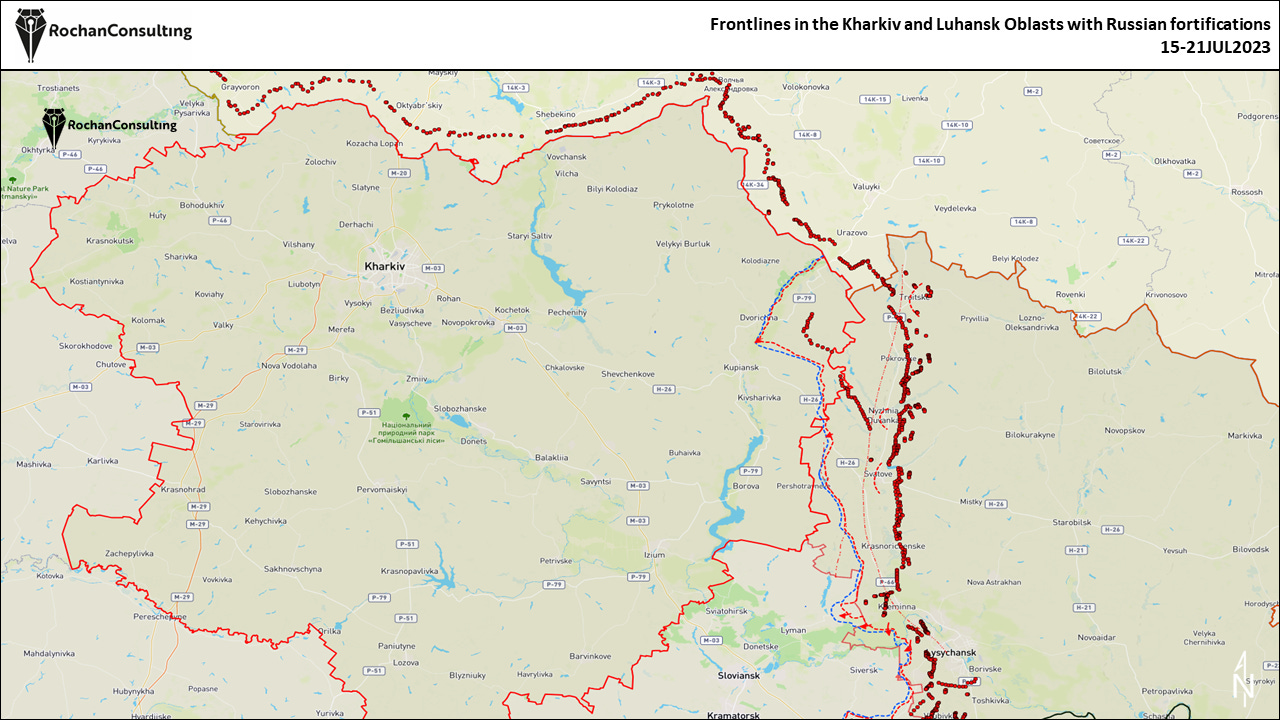
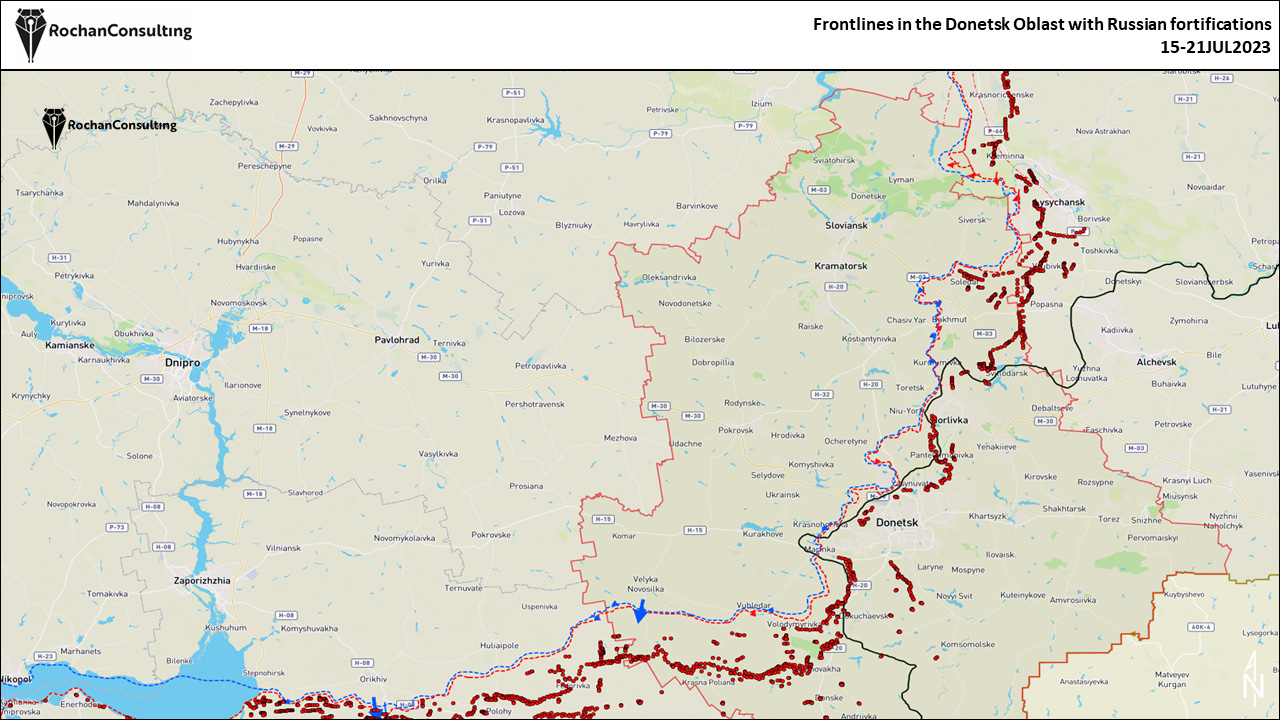
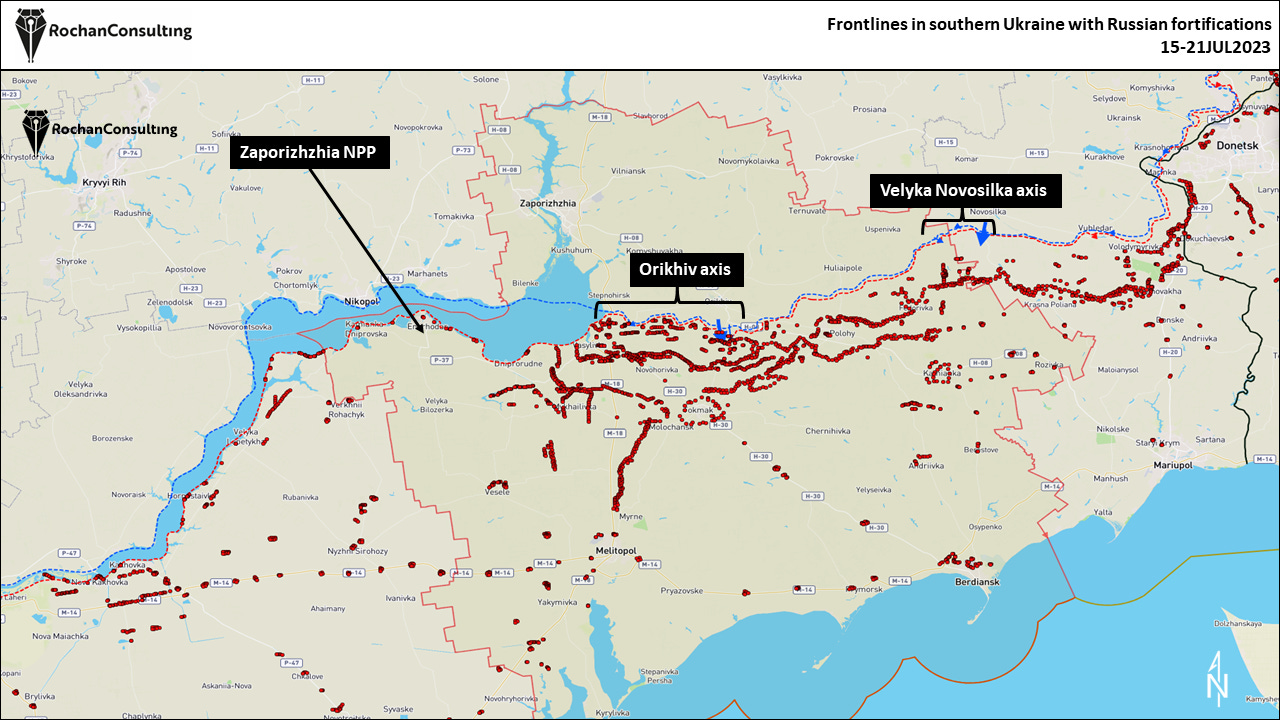
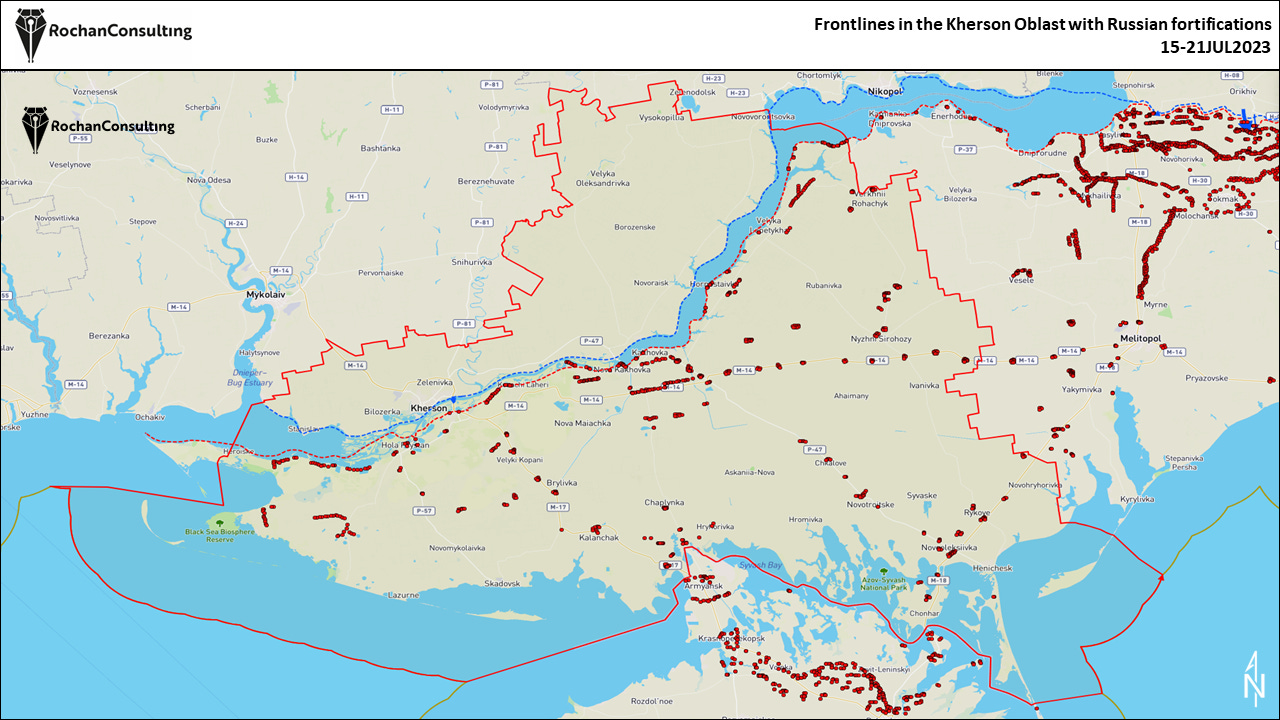
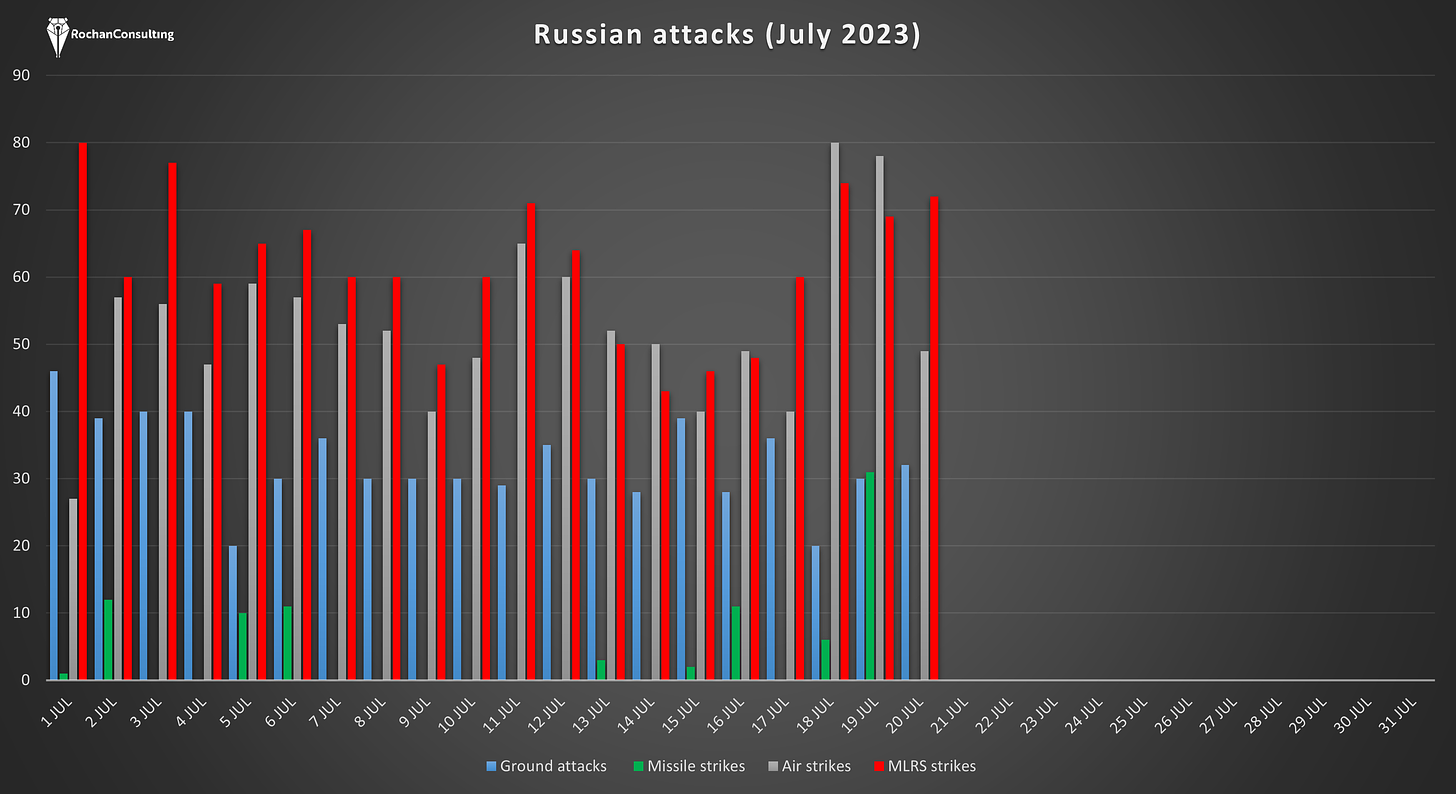
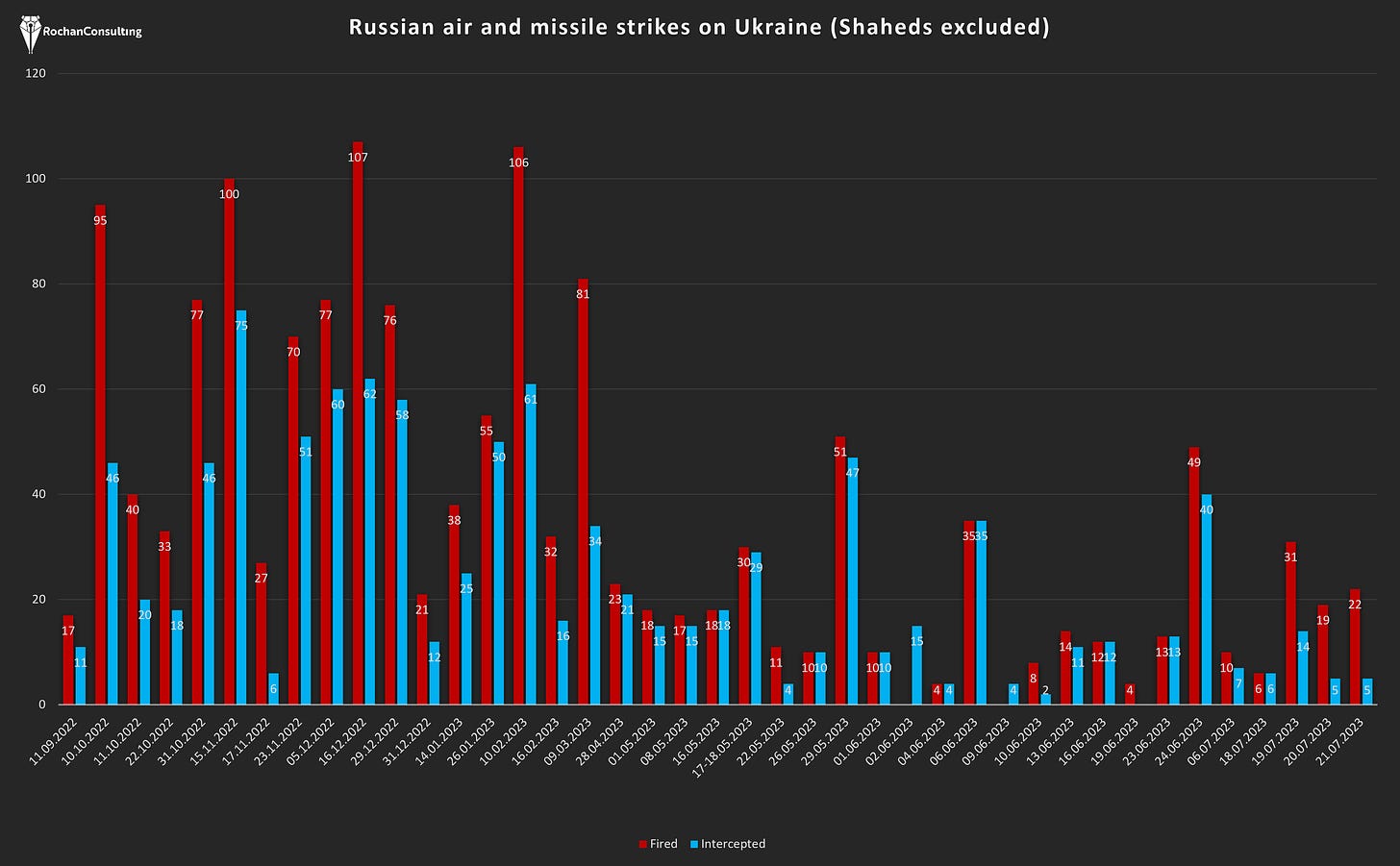
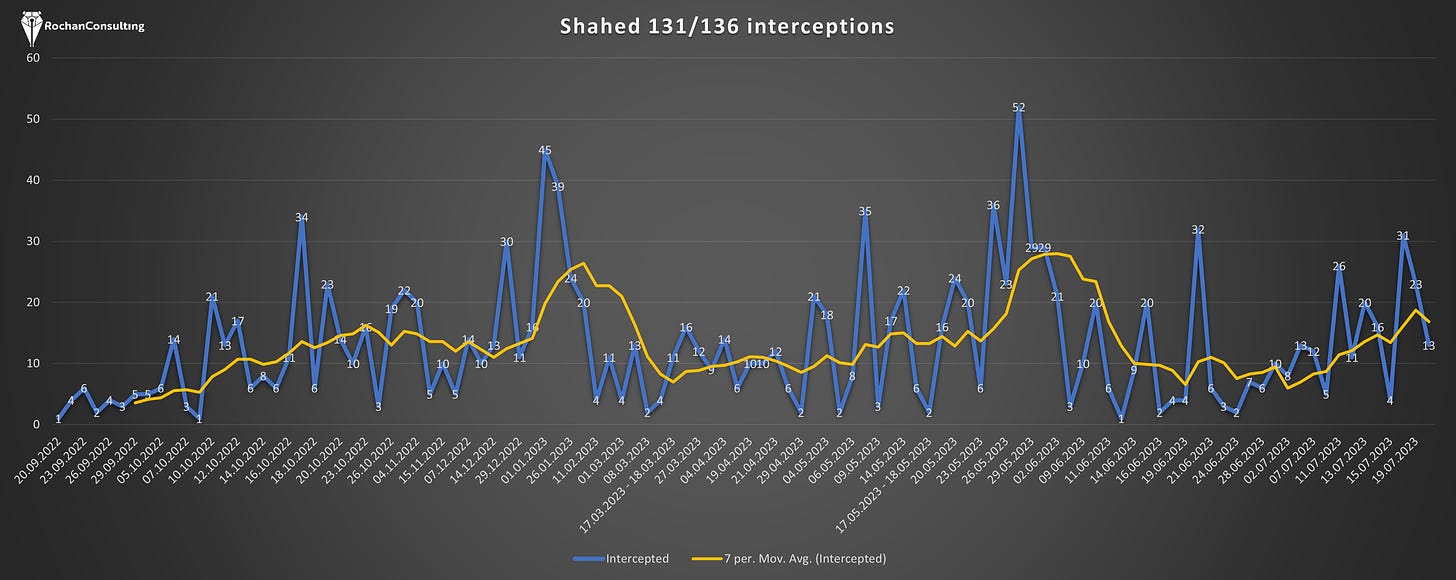

Sad. Ukraine taking a few more towns, or Bakhmut, in this offensive won't really accomplish much. Some of these problems seem fixable. E.g., you can give Bradleys to the more experienced units. Send new units to go defend. Send experienced units to go do six more weeks of intensive training on synchronizing attacks. Presumably allies too will get the message that Ukraine needs more breaching equipment. Also, it does appear the few long-range Storm Shadows that Ukraine has used has been used rather effectively -- they are hitting high-value command posts, ammo depots, and infrastructure.
My only hope is that Ukraine purposefully struck a negative tone among a group of visitors they'd know are read in Washington in order to (1) get more weapons, and (2) start a PR campaign for the offensive ending so perhaps they can restart an offensive later with a bit of an element of surprise.
Still, the consequences of this failure to really not accomplish much of anything seem severe. Will a winter offensive really yield much better results? Russia can dig in more in key areas. Lay even more mines. As you say, F-16s are not thought to be game changers. Seems now Ukraine needs to negotiate peace in return for giving up the south. They won't do this so from now on kind of looks like an endless, pointless war. One likely to simply kind of fizzle out near current de facto borders over a period of years with no real peace.
Insight Prediction odds now of cutting the land bridge by the end of the summer campaign season now at 3-6%. https://insightprediction.com/m/154445/will-ukraine-sever-the-land-bridge-to-crimea-by-september-30th-2023